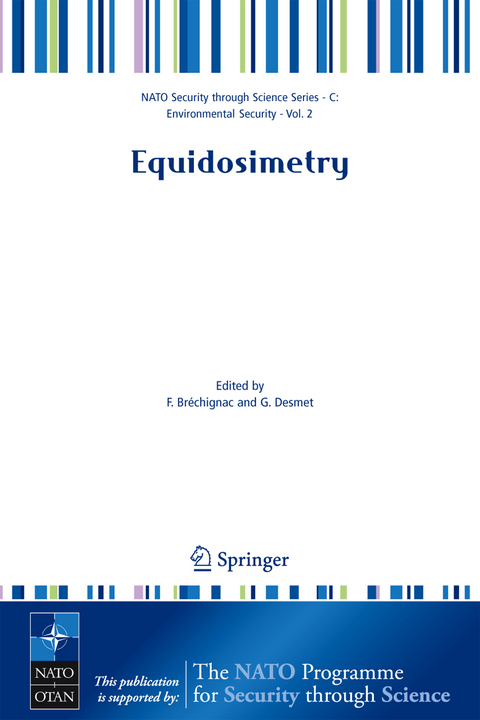
Equidosimetry
Springer-Verlag New York Inc.
978-1-4020-3648-4 (ISBN)
In radioecology and radiation protection, methods of radiation dosimetry are key for dose assessment. It is therefore highly desirable to develop a clear theoretical approach as well as a practical method of equidosimetry that would allow for an ecological normalization of the different stressors in unified uniform units, especially for comparison purposes.
Approaches to Ecological Standardization.- Problems of Ecological Standardization and Dosimetry of Action of Different Factors on Biota of Ecosystems.- The Principal Approaches to Standardization of Technogenic Contamination of Environment.- Estimation of Parameters of Radiocapacity of Biota in Ecosystems; Criteria of Their Well-Being.- Approaches to Equidosimetry in Ecology.- Equidosimetry: A Reflexion on Risk Assessment.- An Equi-Dosimetric Approach to the Comparison of Radiation and Chemical Effects on Natural Populations of Aquatic Organisms.- Determination of Heterogeneity Biota as a Perspecve Parameter of Ecological Standardization.- Phytoviruses as Indicators of Environment.- Protein and Radioactivity Levels of Patella Coerulea Linnaeus Around Dardanelles.- Equidosimetric Comparison of Efficiency of Effects of Gamma-Irradiation and Chemical Toxic Agents (Copper and Phenol) on the Red Algae of the Black Sea.- Macrophytes as Bioindicators of Radionuclide Contamination in Ecosystems of Different Aquatic Bodies in Chernobyl Exclusion Zone.- Effects of Radioactive and Chemical Pollution on Plant Virus Frequency Distribution.- Species Diversity as a Factor of Radiostability of Algal Cenosis.- Radioecology and Ecotoxicology in General Ecology.- Modern Problems of Ecotoxicology.- Ecosystem GIS-Modelling in Ecotoxicology.- Mapping Transfer Parameters of Radionuclides in Terrestrial Environments.- Radioecological Factors of the Geological Environment within Ukrainian Territory.- Behaviour of the Radionuclides in Peat Soils.- Evaluation of the Effect of Dnipro River Reservoirs on Coastal Landscapes.- Radiation Effects on the Populations of Soil Invertebrates in Belarus.- Problems of Estimation of Risks from Different Factors.- Generalized Ecosystem Indices: Ecological Scaling and Ecological Risk.- Ecological Risk Assessmenty as a Method for Integrating Risks from Multiple Stressors at Hazardous Waste Sites.- Comparing Risks from Exposure to Radionuclides and other Carcinogens at Arctic Coal Mines.- Risk Due to Joint Chemical and Radiation Contamination of Food.- Problems of Synergism of Different Pollutants.- Synergetic Effects of Different Pollutants and Equidosimetry.- The Behaviour of Radionuclides and Chemical Contaminants in Terrestrial and Water Ecosystems of Urals Region.- Synergism of Low Dose Chronic Radiation and Biotic Stress for Plants.- Comparative Study of the Effects of Endocrine Disruptor and Ionizing Radiation with Plant Bioassay.- Genetic Factors, Environment and Toxicants.- Cytogenetic Effects in Plants after Weak and Combined Exposures and a Problem of Ecological Standardization.- Role of Various Components of Ecosystems in Biogeochemical Migration of Pollutants of Antropogenic Origin in Forests.- Ecological Inspection of Military Objects.- The Procedure of Military Sites Rehabilitation with Optimal Planning of Tender Orders.- Modeling and Simulation of 137Cs Migration in Boreal Forest Ecosystems.- Behavior of Cs-137 and Sr-90 on Fish Ponds in Ukraine.- Genetic Effects of Chronic Gamma-Irradiation at a Low Dose Rate: Experimental Study on CBA/LAC Mice.- Applied Radioecology and Ecotoxicology.- Methods and Tasks of Radiation Montioring of Forest Ecosystems.- Similarities and Differences in Behavior of 137Cs, 40K and 7Be in Natural Ecosystems.- Heavy Metals Accumulation by Agricultural Crops Grown on Various Types of Soil in Polessje Zone of Ukraine.- The Brilliant Blue Method for Water Soluble Chernobyl 137Cs Behaviour Estimation in Soils of South Belarus.- Aquatic Ecosystems Within the Chernobyl NPP Exclusion Zone: TheLatest Data on Radionuclide Contamination and Absorbed Dose for Hydrobionts.- Role of Higher Plants in the Redidstribution of Radionuclides in Water Ecosystems.- Problems of the Radiation Safety on Military Objects of Ukraine.- Landscape Criticality Indexes for the Different Pollutants.- Ecosystems of 30-KM Zones of Khmelnytsky and Rivne NPP: Estimation of Migration Conditions of the Radionuclides and Other Technical Pollutants.- Possibility of Standardization of Radionuclides and Chemotoxicants.- Radionuclides 137Cs and 60Co Uptake by Freshwater and Marine Microalgae Chlorella, Navicula, Phaeodactylum.- Principal Component Analysis of Chronic Influence of Low-Doses of Ionizing Radiation and Cadmium on Organisms.- Characterization and Treatment of Actinide Contaminated Soils and Well Waters.- The Endogenic and Exogenic Factors of the Realization of Phenotypic Adaptation.- Biological Approach to Evaluating the Ecological Safety of Radioactive Waste Disposal System: Study of Small Rodents.- Use of Photosynthesis and Respiration of Hydrophytes for Water Toxicity Definition.
| Erscheint lt. Verlag | 18.10.2005 |
|---|---|
| Reihe/Serie | Nato Security through Science Series C: |
| Zusatzinfo | XVI, 436 p. |
| Verlagsort | New York, NY |
| Sprache | englisch |
| Maße | 156 x 232 mm |
| Themenwelt | Naturwissenschaften ► Biologie ► Ökologie / Naturschutz |
| Naturwissenschaften ► Chemie ► Technische Chemie | |
| Naturwissenschaften ► Physik / Astronomie ► Angewandte Physik | |
| Technik | |
| ISBN-10 | 1-4020-3648-5 / 1402036485 |
| ISBN-13 | 978-1-4020-3648-4 / 9781402036484 |
| Zustand | Neuware |
| Haben Sie eine Frage zum Produkt? |
aus dem Bereich


